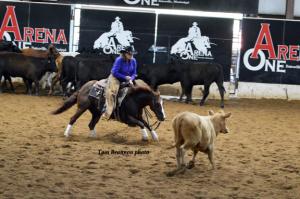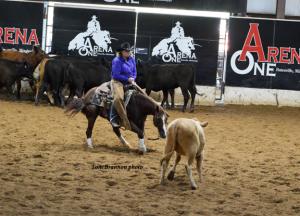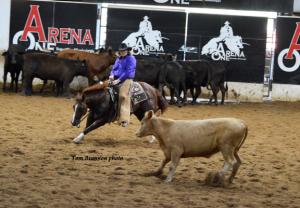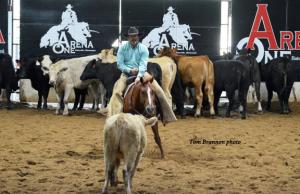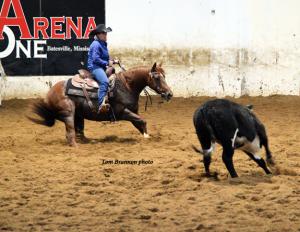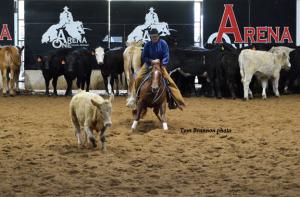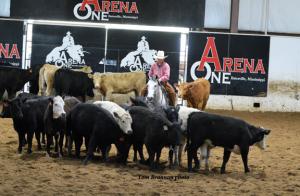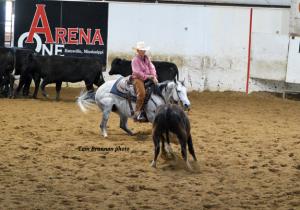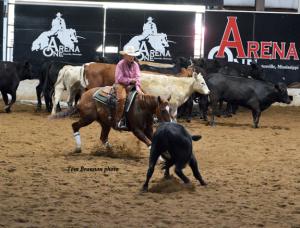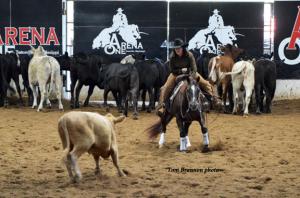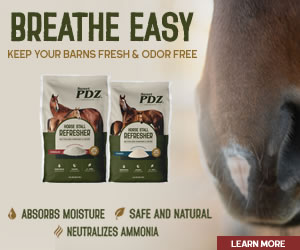By Tommy Brannon
Things have been busy this spring at Arena One in Batesville, Mississippi. Owner and head trainer Lee Garner and Manager Suzy Barnett hosted four National Cutting Horse Association (NCHA) events with two in March and two in April. In addition to the NCHA shows, Arena One was the venue for a Bureau of Land Management Mustang adoption April 7-8, 2017.
The facility lends itself well to cutting horse shows. The main arena is air conditioned and large enough to divide into sections for warm up and simultaneous runs. The judge’s stands and the spectator areas are elevated so it is easy to watch the action. There are two additional covered arenas, cattle pens, horse walkers, wash racks, plenty of RV hook ups, and about 700 stalls. The footing is well maintained for cutting horses and much of the stock is on premises.
This particular event was a Mid-South Cutting Horse Association show, March 30- April 2, 2017, with $500 added. The judge was Don Crumpler (AAAA) from Wichita Falls, Texas. All classes were one go-round, and Open riders were permitted to ride two horses.
For those readers who may not be familiar with the nuances of cutting horses, the following is a good description of the sport provided by the NCHA.
“Cutting events consist of individual runs in each class within their respective divisions. Each contestant is allowed 2½ minutes to show their horse to a panel of judges. A contestant is assisted by four helpers of their choice: two are designated as turnback help to keep cattle from running off to the back of the arena, and the other two are designated as herd holders to keep the cattle bunched together and prevent potential strays from escaping into the work area. A contestant is required to make at least two cuts from the herd, one of which must be a cut from deep inside the herd, while the other(s) can be peeled from the edges. Once the cut has been made and the selected calf has been driven clear of the herd, the contestant commits the horse to that cow by dropping his rein hand to the horse's neck, which allows for more slack in the reins and gives the horse its head. At that point it is almost entirely up to the horse to prevent the calf from returning to the herd – a job the best horses do with relish, savvy, and style. Judges will score a run on a scale from 60 to 80, with 70 being an average score. A performance is judged on a number of factors in which points are added or subtracted.
“Points are added (or subtracted) for courage, eye appeal, herd work, controlling the cow, degree of difficulty, time worked, and loose reins. A rider can be disqualified for using illegal equipment, leaving the working area before the time limit is reached, and for inhumane treatment of the horse. A horse and rider team is penalized if forced off a cow, if the horse charges a cow, for excessive herd holder help, and judges either add or take away points based on the horse and rider's performance throughout their run.”
There are usually seven to eight competitors in a run and the payouts can be several hundred dollars at local weekend shows and as high as $50,000 at the NCHA Championships.
In addition to Arena One, NCHA shows in the mid-south take place at the Roane State Expo Arena in Harriman Tenn., The Kirk Fordyce Equestrian Center in Jackson, Miss., the Canton Multipurpose Arena in Canton, Miss., and Wilson County Fair Grounds in Lebanon, Tenn.
Things have been busy this spring at Arena One in Batesville, Mississippi. Owner and head trainer Lee Garner and Manager Suzy Barnett hosted four National Cutting Horse Association (NCHA) events with two in March and two in April. In addition to the NCHA shows, Arena One was the venue for a Bureau of Land Management Mustang adoption April 7-8, 2017.
The facility lends itself well to cutting horse shows. The main arena is air conditioned and large enough to divide into sections for warm up and simultaneous runs. The judge’s stands and the spectator areas are elevated so it is easy to watch the action. There are two additional covered arenas, cattle pens, horse walkers, wash racks, plenty of RV hook ups, and about 700 stalls. The footing is well maintained for cutting horses and much of the stock is on premises.
This particular event was a Mid-South Cutting Horse Association show, March 30- April 2, 2017, with $500 added. The judge was Don Crumpler (AAAA) from Wichita Falls, Texas. All classes were one go-round, and Open riders were permitted to ride two horses.
For those readers who may not be familiar with the nuances of cutting horses, the following is a good description of the sport provided by the NCHA.
“Cutting events consist of individual runs in each class within their respective divisions. Each contestant is allowed 2½ minutes to show their horse to a panel of judges. A contestant is assisted by four helpers of their choice: two are designated as turnback help to keep cattle from running off to the back of the arena, and the other two are designated as herd holders to keep the cattle bunched together and prevent potential strays from escaping into the work area. A contestant is required to make at least two cuts from the herd, one of which must be a cut from deep inside the herd, while the other(s) can be peeled from the edges. Once the cut has been made and the selected calf has been driven clear of the herd, the contestant commits the horse to that cow by dropping his rein hand to the horse's neck, which allows for more slack in the reins and gives the horse its head. At that point it is almost entirely up to the horse to prevent the calf from returning to the herd – a job the best horses do with relish, savvy, and style. Judges will score a run on a scale from 60 to 80, with 70 being an average score. A performance is judged on a number of factors in which points are added or subtracted.
“Points are added (or subtracted) for courage, eye appeal, herd work, controlling the cow, degree of difficulty, time worked, and loose reins. A rider can be disqualified for using illegal equipment, leaving the working area before the time limit is reached, and for inhumane treatment of the horse. A horse and rider team is penalized if forced off a cow, if the horse charges a cow, for excessive herd holder help, and judges either add or take away points based on the horse and rider's performance throughout their run.”
There are usually seven to eight competitors in a run and the payouts can be several hundred dollars at local weekend shows and as high as $50,000 at the NCHA Championships.
In addition to Arena One, NCHA shows in the mid-south take place at the Roane State Expo Arena in Harriman Tenn., The Kirk Fordyce Equestrian Center in Jackson, Miss., the Canton Multipurpose Arena in Canton, Miss., and Wilson County Fair Grounds in Lebanon, Tenn.
